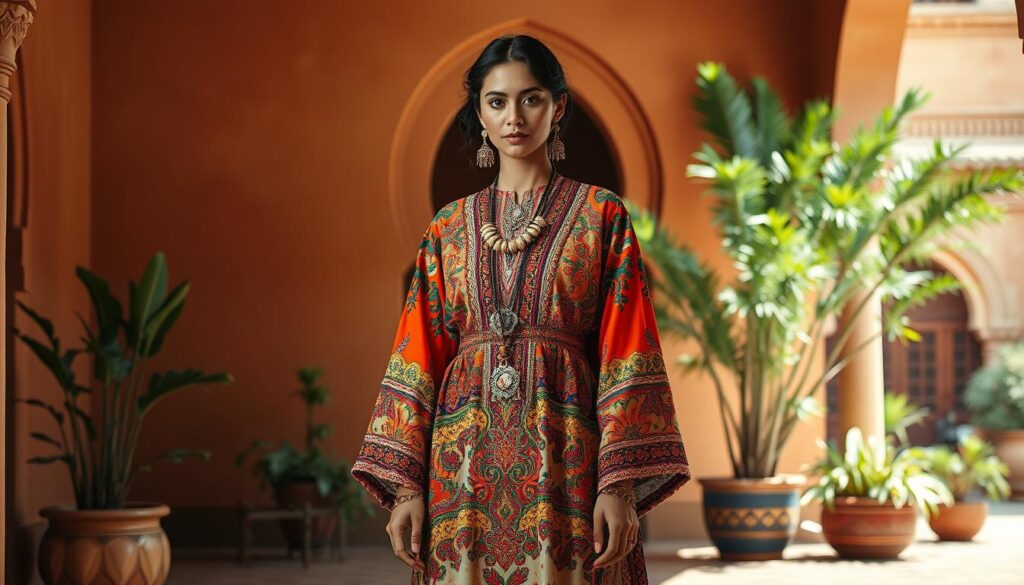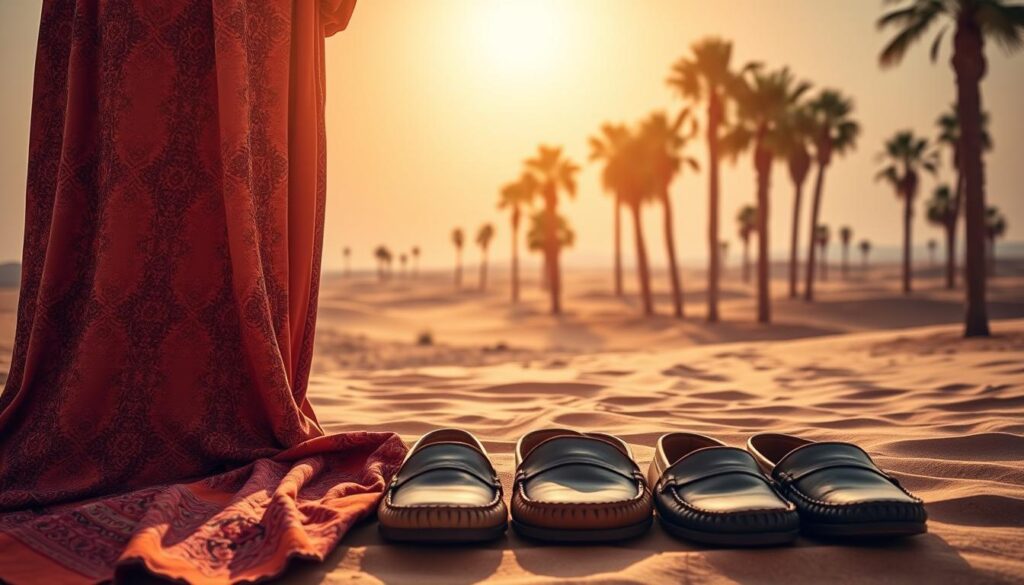Are you aware of the cultural nuances that can make or break your travel experience in Morocco? As a predominantly Muslim country, Morocco adheres to conservative dressing norms, especially for women. Understanding the local culture and dressing accordingly is crucial for a respectful and enjoyable trip.
When visiting Morocco, you’ll encounter a diverse range of destinations, from the coastal town of Essaouira to the vibrant city of Marrakech and the serene Sahara Desert. Dressing modestly will not only show respect for the local customs but also help you blend in and minimize unwanted attention.
For a personalized travel experience or to book your Moroccan adventure, you can contact Morocco Disney Tours at +16823085820 / +212773081754 or email [email protected].
Key Takeaways
- Understand the importance of dressing conservatively in Morocco.
- Learn practical style tips for both men and women.
- Discover how to pack appropriately for different regions and seasons.
- Blend in with locals and avoid unwanted attention.
- Find the right balance between respecting local customs and expressing your personal style.
Understanding Moroccan Dress Culture
Understanding the dress culture in Morocco is essential for visitors to navigate the country’s social environments respectfully. Morocco is a predominantly Muslim country, and its dress culture reflects this, with modesty being a highly valued trait in both men’s and women’s attire.
The Importance of Modest Dressing in Morocco
Moroccan dress culture is deeply rooted in Islamic traditions. Modest dressing is not just a sign of respect for the local culture; it also helps visitors avoid unwanted attention. By dressing conservatively, tourists can create more authentic connections with the local people. In Morocco,dressing modestly is a sign of respectfor the country’s culture and values.
How Locals Dress vs. Tourist Expectations
The way locals dress in Morocco varies greatly. Some women wear traditional djellabas and headscarves, while others dress in a more modern or European style. Men typically wear loose pants and shirts, with some wearing traditional jellabas and tarboosh caps. Tourists often dress differently, which can create cultural disconnects. However, Moroccans don’t expect visitors to dress exactly like locals. Making an effort todress conservatively demonstrates cultural sensitivity. In major tourist areas like Marrakech, a wider range of clothing styles is seen, but rural areas tend to be more traditional.

By understanding and respecting local dress customs, visitors can have a more positive and enriching experience in Morocco. Dressing modestly isn’t just about respect; it’s also a way to engage more deeply with the local culture.
How to Dress in Morocco: Essential Guidelines
To navigate Morocco’s vibrant cities and rural landscapes with confidence, it’s essential to know the basics of Moroccan dress etiquette. Understanding and respecting local customs through your attire can significantly enhance your travel experience.
Basic Rules for Respectful Attire
Dressing respectfully in Morocco involves covering your shoulders and knees. Both men and women should avoid wearing shorts and sleeveless tops in public spaces. Instead, opt for loose-fitting clothing that not only respects local customs but also keeps you cooler in the hot weather. Avoid low-cut shirts that expose cleavage, as this is considered immodest.
When visiting rural areas or traditional neighborhoods, it’s advisable to dress more conservatively. Carrying a scarf can be useful, not just for modesty but also as a practical accessory.
Do Women Need to Cover Their Hair?
A common misconception about traveling to Morocco is that women must cover their hair. While it’s true that some Muslim countries require this, Morocco is generally more relaxed. Women are not required to cover their hair in most public places. However, it’s a good idea to carry a lightweight scarf for visits to mosques or religious sites, where covering your hair may be expected as a sign of respect.
For tips on what to wear, consider the local culture and the activity. Avoid wearing swimsuits outside of beach or pool areas, and be mindful of your attire when visiting someone’s home, where modest dressing is a sign of respect.

Weather-Appropriate Clothing for Morocco
The diverse Moroccan climate demands adaptable clothing choices to ensure comfort throughout your journey. Morocco’s weather varies significantly across different regions and seasons, making it crucial to pack accordingly.
Seasonal Considerations
Morocco experiences a wide range of temperatures across different seasons. In the winter months (December to February), temperatures can drop to around 40°F (4°C) at night, especially in the mountains. In contrast, summer (June to August) brings intense heat, with temperatures often exceeding 100°F (38°C) in inland cities like Marrakech and Fez. The shoulder seasons, spring and fall, offer more pleasant weather, but it’s still essential to be prepared for varying conditions.
Lightweight, breathable fabrics such as cotton, linen, and moisture-wicking materials are ideal for managing the heat while maintaining modesty. Protecting yourself from the intense Moroccan sun is also vital; consider packing sunglasses, a hat, and sunscreen.
Layering Tips for Temperature Fluctuations
Given the significant temperature variations between day and night, layering is key to comfort in Morocco. Even in the summer, evenings can be cool, especially in coastal areas like Essaouira and Tangier. Pack lightweight base layers that can be supplemented with a light jacket or wrap for cooler evenings. This approach allows you to adapt to the changing temperatures throughout the day.

Women’s Clothing Guide for Morocco
The key to dressing in Morocco is modesty, and there are several stylish ways to achieve this. Women traveling to Morocco will find that dressing respectfully is not only a cultural necessity but also a way to blend in with the locals.
Recommended Tops and Bottoms
For women, loose-fitting pants are a versatile and essential item for Morocco. Linen or cotton wide-leg pants and palazzo styles offer both comfort and cultural appropriateness. When it comes to tops, opt for loose-fitting blouses, tunics, and t-shirts with sleeves that cover the shoulders. These can be easily mixed and matched with different bottoms.
Dresses and Skirts: What Works Best
Maxi dresses and skirts that reach the ankles are perfect for Morocco, especially those with higher necklines and at least cap sleeves. When selecting dresses, choose styles that don’t cling to the body—wrap dresses, shirt dresses, and A-line cuts work well while keeping you cool.
Swimwear and Beach Attire
For beach and pool areas at hotels, standard swimwear including bikinis is acceptable. However, always carry a cover-up in your bag for walking through public areas. Layering is key—a light cardigan or kimono in your day bag can be added when entering more conservative areas or religious sites.
By choosing the right clothing, women can enjoy their time in Morocco while respecting local customs.
Men’s Clothing Guide for Morocco
When traveling to Morocco, men should be mindful of their attire to respect local customs. Morocco is a conservative country, and dressing modestly is essential to avoid offending locals.
Appropriate Shirts and Pants
Men should pack lightweight, breathable pants that cover the knees. Linen pants, chinos, and lightweight cotton trousers are ideal choices. While jeans are acceptable, they can become uncomfortable in the heat, so opt for lighter weight denim if you choose to bring a pair.
For shirts, men should select options with at least short sleeves that cover the shoulders. Button-downs, polos, and t-shirts in breathable fabrics work well. Linen or cotton shirts are particularly suitable as they provide comfort in the heat while maintaining a put-together appearance.
| Pant Type | Shirt Type | Comfort Level |
|---|---|---|
| Linen Pants | Linen Shirt | High |
| Chinos | Cotton Shirt | High |
| Jeans | Lightweight T-shirt | Medium |
Footwear and Accessories
Footwear should be practical for walking on uneven surfaces. A comfortable pair of closed-toe shoes like sneakers or loafers is essential. A second pair of shoes, such as sandals, provides a good alternative for less demanding days or casual evenings.
Accessories like a lightweight scarf can be useful for men too, particularly for desert excursions where protection from sun and sand is needed. A small crossbody bag or daypack is practical for carrying essentials like water, sunscreen, and a light layer for temperature changes.
What NOT to Wear in Morocco
Dressing modestly is key to a hassle-free trip to Morocco, where cultural norms are deeply rooted. Understanding what to avoid wearing can significantly enhance your travel experience.
Common Tourist Mistakes to Avoid
Tourists often make the mistake of wearing revealing clothing, which can attract unwanted attention. Avoid wearing tank tops, shorts, and mini skirts, as these are considered inappropriate in most settings.
- Leave revealing clothing like short shorts and tank tops at home or reserve them for private hotel spaces.
- Opt for looser styles instead of tight-fitting clothes to avoid attracting unnecessary attention.
- Avoid clothing with potentially offensive graphics or slogans.
Special Considerations for Religious Sites
When visiting mosques or religious sites, it’s essential to dress more conservatively. Women should carry a scarf to cover their hair, and ensure their shoulders, arms, and legs are fully covered.
| Location | Dress Code |
|---|---|
| Religious Sites | Cover hair, shoulders, arms, and legs |
| Rural Areas | Dress conservatively, consider wearing a scarf on your head |
| Beach/Pool Areas | Swimwear and casual attire acceptable |
By following these tips, you can ensure a more enjoyable and respectful trip to Morocco.
Conclusion: Packing Smart for Your Moroccan Adventure
Embarking on a Moroccan journey means embracing a culture that values modesty and respect. To ensure a harmonious and enriching travel experience, packing thoughtfully is key. Your Morocco packing list should include versatile, modest clothing that can be mixed and matched, such as loose pants, long skirts, maxi dresses, and lightweight tops with sleeves.
For women, prioritizing comfortable yet modest attire is essential, with multiple light layers for adjusting to temperature changes throughout the day. Men should pack breathable shirts, lightweight pants, and comfortable shoes. Remember, your hotel may have different dress standards than public spaces, so it’s wise to check ahead.
For personalized advice on planning your Moroccan adventure, including customized itineraries, contact Morocco Disney Tours at +16823085820 / +212773081754 or email [email protected]. By respecting Moroccan dress customs, you’ll enhance your travel experience through more positive interactions with locals. Use resources like Skyscanner for flights, Booking.com for hotels, and Viator for tours to make your trip planning seamless.